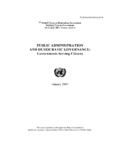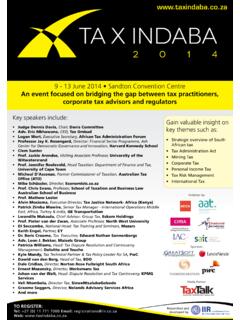Transcription of Use of Technology in Tax Administrations 2: Core ...
1 TECHNICAL NOTES AND MANUALSUse of Technology in Tax Administrations 2: core information Technology Systems In Tax AdministrationsPrepared by Margaret Cotton and Gregory Dark With contributions from Peter Menhard and John Ryan Authorized for distribution by Sanjeev GuptaFiscal Affairs DepartmentINTERNATIONAL MONETARY FUNDINTERNATIONAL MONETARY FUNDF iscal Affairs DepartmentUse of Technology in Tax Administrations 2: core information Technology Systems in Tax AdministrationsPrepared by Margaret Cotton and Gregory Dark With contributions from Peter Menhard and John RyanAuthorized for distribution by Sanjeev GuptaMa rch 2017 DISCLAIMER: This Technical Guidance Note should not be reported as representing the views of the IMF.
2 The views expressed in this paper are those of the author(s) and do not necessarily represent the views of the IMF, its Executive Board, or IMF Classification Numbers: H20, H29, M10, M15 Keywords: Tax administration , information Technology , procurement, commercial-off-the-shelf acquisition, COTS, core tax system functionalityAuthors E-Mail Addresses: NOTES AND MANUALSUse of Technology in Tax Administrations 2: core information Technology Systems in Tax AdministrationsFiscal Affairs DepartmentMarch 2017 INTERNATIONAL MONETARY FUNDThis technical note is the second of three addressing information Technology themes and issues relevant to tax Administrations .
3 This note addresses how to select a suitable information Technology (IT) system for core tax administration functions. The first note covers the use of IT in tax Administrations and how to develop an information Technology strategic plan (ITSP) and is intended for developing country tax Administrations that are largely manual or have outdated legacy IT systems. The third note focuses on implementation of a commercial-off-the-shelf (COTS) system in a developing country tax administration . Ideally, the notes would be read in order but a tax administration that already has an ITSP may choose to go to note two to determine the type of system most suited to its circumstances or straight to note three if the preferred system has been selected.
4 The content of these technical notes reflects the themes and issues the IMF Revenue administration Divisions are frequently called upon to assist member countries technical notes are primarily for use by tax Administrations that have no Technology to manage their core tax processes, or their Technology is limited and outdated. The notes may however, also be of interest to more advanced Administrations . These notes focus on core tax functions and do not address other business systems ( , payroll, finance, document, and asset management systems).
5 For advanced IT tax Administrations , there is a wealth of other information available including the OECD forum on Tax administration publication: Technologies for Better Tax administration . A Practical Guide for Revenue Bodies, May, 1 Notes and Manuals 17/02 | 2017 1 TECHNICAL NOTES AND MANUALSUse of Technology in Tax Administrations 2: core information Technology Systems in Tax Administrations2 Margaret Cotton and Gregory Dark3 This technical note and manual (TNM) addresses the following questions: How to decide to keep or replace systems?
6 How can the build versus buy decision be made? What is a typical set of functionalities seen in a modern administration ? How can a product be selected? What contract issues need to be considered? How long will it take to complete the project?Sophisticated information Technology (IT) support has become an essential part of the fabric of modern tax Administrations . IT plays a pivotal role in all aspects of tax administration taxpayer interactions and service, registration, processing, accounting, work automation, workflow regulation, case management, and risk analysis and treatment.
7 As Administrations mature, the need for significant changes to the level of IT support well as being an essential part of a tax system s operation, the level of investment in IT systems is a significant proportion of an administration s budget, both in terms of capital and ongoing expenditure. Shortcomings in IT support for key functions or directions will eventually raise the question of whether a system needs How to Decide to Keep or Replace Systems?23In general, a decision on whether to keep or replace systems can be made using four parameters: suit-ability; maintainability; risk; and technical viability.
8 These are examined in Box Administrations that have very little or rudimentary IT support for their operations (Category 1 Administrations ) will not need to go past the first parameter, as whatever systems support they have is by definition insufficient. However, all parameters will apply, though to different extents, to those tax Administrations which have IT systems that have not kept up with their needs (Category 2) Administrations as well as more advanced The OECD Tax administration 2015: Comparative information on OECD and Other Advanced and Emerging Economies reported average IT costs for all OECD revenue agencies at around 11-12 percent of total expenditure with some reporting over 20 percent of total expenditure.
9 For non-OECD countries the expenditure is generally much Margaret Cotton is a Senior Economist in the Fiscal Affairs Department of the IMF. Gregory Dark is a member of the IMF s roster of fiscal Technical Notes and Manuals 17/02 | 2017 Box 1. Replace or Maintain/Enhance?Suitability As business models evolve, systems in place may no longer have the necessary functionality4 to provide the support that is needed. An assessment needs to be made whether it is more effective to rebuild/add new functionality to the existing system or to replace it with a system which can provide that Over time, systems architecture5 also evolves.
10 Modern design such as a service-oriented, message based, loosely coupled service-oriented architecture has replaced systems featuring high levels of integration and tight coupling6 of functions. As well, modern design allows regularly changed parameters such as tax rates, form labels, etc. to be dealt with by simple configuration of codes tables or rules, rather than needing changes to the actual program code which is a much more complicated Over the life of a system, maintenance costs (both in dollar terms and available knowledge of legacy systems8) will rise to a degree where they are no longer sustainable, indicating the need for to the business Again, over time, the complexity of a system typically increases, reflecting business and systems improvement/fixes.









